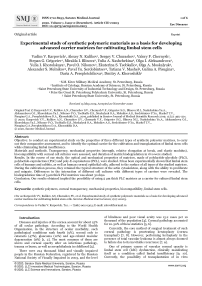Experimental study of synthetic polymeric materials as a basis for developing advanced carrier matrices for cultivating limbal stem cells
Автор: Vadim V. Karpovich, Alexey N. Kulikov, Sergey V. Churashov, Valery F. Chernysh, Stepan G. Grigoriev, Miralda I. Blinova, Yulia A. Nashchekina, Olga I. Aleksandrova, Yulia I. Khorolskaya, Pavel O. Nikonov, Ekaterina S. Tsobkallo, Olga A. Moskalyuk, Alexander S. Melnikov, Pavel Yu. Serdobintsev, Tatiana V. Mashel, Galina A. Pisugina, Daria A. Perepletchikova, Dmitry A. Khoroshikh
Журнал: Saratov Medical Journal @sarmj
Статья в выпуске: 2 Vol.1, 2020 года.
Бесплатный доступ
Objective: to conduct an experimental study on the properties of three different types of synthetic polyester matrices, to carry out their comparative assessment, and to identify the optimal carrier for the cultivation and transplantation of limbal stem cells while eliminating limbal insufficiency. Materials and methods. Transparency, mechanical properties (strength, relative elongation at break, and elastic modulus), biocompatibility with corneal cell cultures were assessed, and duration of matrix biodegradation in vivo were studied. Results. In the course of our study, the optical and mechanical properties of matrices, made of polylactide-glycolide (PLG), polylactide-caprolactone (PLC) and poly-E-caprolactone (PCL), were studied. It has been experimentally shown that limbal stem cells of humans and rabbits, as well as human corneal epithelial cells, adhered to the surface of all types of the studied matrices. During the cultivation process, they retained the typical structure of the actin cytoskeleton, along with the ability to proliferate and migrate. Differences in the interaction of different cell cultures with different types of carriers were revealed. The biodegradation time of 5 μm thick PLC matrices was about 30 days. Conclusion. Our results obtained implied the possibility of using 5 μm thick PLC matrices as a carrier for cultured limbal stem cells.
Synthetic polymers, corneal transparency, mechanical properties, biocompatibility, limbal stem cells
Короткий адрес: https://sciup.org/149135013
IDR: 149135013 | DOI: 10.15275/sarmj.2020.0203
Список литературы Experimental study of synthetic polymeric materials as a basis for developing advanced carrier matrices for cultivating limbal stem cells
- Global Initiative for the Elimination of Avoidable Blindness. Geneva: World Health Organization, 1997; 48.
- Pascolini D. Global estimates of visual impairment: 2010. Br J Ophthalmol 2012; 96 (5): 614-8. https://doi.org/10.1136/bjophthalmol-2011-300539
- Lim AS. Mass blindness has shifted from infection (onchocerciasis, trachoma, corneal ulcers) to cataract. Ophthalmologica 1997; 211 (4): 270. https://doi.org/10.1159/000310806.
- Libman ES, Shakhova EV. Blindness and visual impairment in the population of Russia. In: VIII Congress of Russian Ophthalmologists. Moscow, 2005; p. 78-9. (in Russian).
- Kasparov AA. Treatment of the most important cornea diseases. In: VIII Congress of Russian Ophthalmologists. Moscow, 2005; p. 450-1. (in Russian).
- Maychuk YuF. Major trends in epidemiology and treatment of eye infections. In: VIII Congress of Russian Ophthalmologists. Moscow, 2005; p. 92-3. (in Russian).
- Slonimsky AYu. Opportunities for penetrating keratoplasty at various pathologies of the anterior eye segment. Clinical Ophthalmology 2001; (3): 102-5. (in Russian). https://doi.org/10.1016/j.ophtha.2008.12.043
- Reinhard Т. Corneal Disease: Recent Developments in Diagnosis and Therapy. Springer-Verlag-Berlin. Heidelberg 2013; 121.
- Chernysh VF, Boyko EV. Eye Burns: State of the Problem and New Approaches. Moscow: GEOTAR-Media 2017; 184. (in Russian).
- Holland EJ, Schwartz GS. The evolution of epithelial transplantation for severe ocular surface disease and a proposed classification system. Cornea 1996; 15: 549-56. https://pubmed.ncbi.nlm.nih.gov/8899265/
- Grueterich M, Espana EM, Tseng SC. Ex vivo expansion of limbal epithelial stem cells: amniotic membrane serving as a stem cell niche. Surv Ophthalmol 2003; 4 (6): 631-46. https://doi.org/10.1016/j.survophthal.2003.08.003
- Pellegrini G, Traverso CE, Franzi AT, et al. Long-term restoration of damaged corneal surfaces with autologous cultivated corneal epithelium. Lancet 1997; 349 (9057): 990-3. https://doi.org/10.1016/S0140-6736(96)11188-0
- Sefat F, et al. Production, sterilization and storage of biodegradable electrospun PLGA membranes for delivery of limbal stem cells of the cornea. Procedia Engineering 2013; 59: 101-16. https://doi.org/10.1016/j.proeng.2013.05.099
- Kulikov AN, Churashov SV, Chernysh VF, et al. Current approaches to the problem of selecting carrier for cultivating limbal stem cells for treating limbal stem cell deficiency. Oftalmologicheskie vedomosti 2018; 11 (2): 48-56. (in Russian). https://doi.org/10.17816/OV11248-56
- Neroev VV, Gundorova RA, Makarov PV, et al. Eye Burns: a Guide for Doctors. Moscow: GOTAR-Media, 2013; 224. (in Russian).


